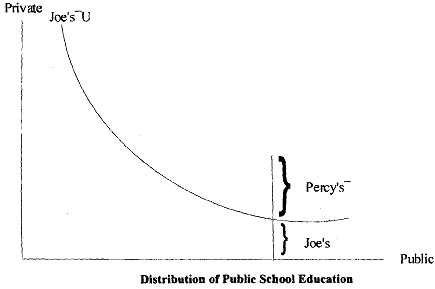Scitovsky Contour for Public Goods:
Suppose we have certain amount of the public good. To derive a Scitovsky contour, we add vertically Joe's and Percy's indifference curves. The slope of the PPF (the rate of product transformation) should be equal to the slope of the Scitovsky contour. With private goods, the slope of the contour was the common MRS of a single individual. With public goods, its slope is the summation of the MRS (summed over all people). So, for public goods:
RPT = ∑MRS
This makes sense because the opportunity cost of producing the public good is the RPT. Since we all get to consume that unit of the public good, its value to different consumers from consuming that unit should be equal to the value of the resources that went into producing that unit. For a private good, because one uses up the resources that went into producing it, it has to be worth it to her to pay for all the resources that went into producing it. With a public good, because all get to use it simultaneously, it has to be worth it for all collectively to pay for the resources that went into producing it.
